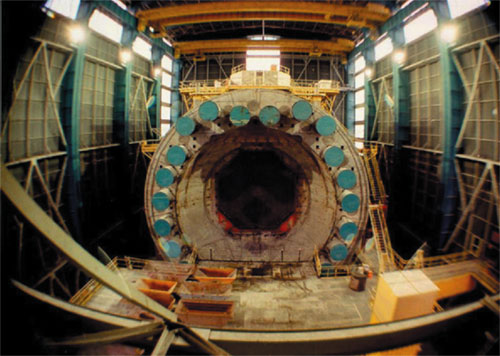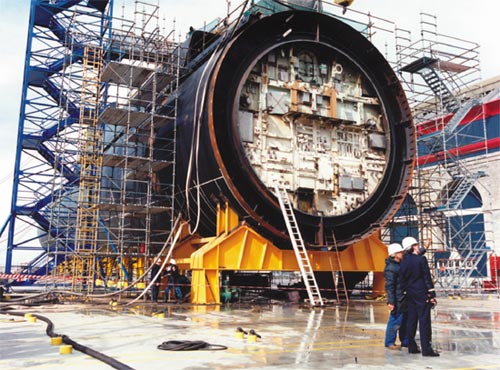A separate system
Using the gaseous diffusion process, the AREVA Pierrelatte facility produced enriched uranium for military use and nuclear fuel for both military and civilian use. This production has now ceased. The quantities of weapons-grade uranium and plutonium produced are classified defence data, as are the quantities of tritium.
For similar reasons, the national inventory drawn up by ANDRA does not include the location or composition of fuels for the reactors of aircraft carriers or submarines, because of the sensitivity of this information. The quantities of these fuels are minimal compared with the quantities produced for civil reactors. The Defence Ministry’s stock of spent fuel was estimated to be 30 tonnes in 2002. This was forecast to increase to 50 tonnes by 2010 and 70 tonnes by 2020. The Defence Ministry’s spent fuel is currently in storage and its future (disposal or reprocessing) is undecided.

Dismantling of prototype reactor G2
The first three French reactors designed to produce weapons-grade plutonium were gas-cooled graphite-moderated reactors (GCRs). Reactors G1, G2 and G3 were in operation from 1956 to 1968, 1958 to 1980 and 1960 to 1984 respectively. They are currently being dismantled. They have graphite stacks and reflectors inside them, which will become waste after dismantling. Around 2400 tonnes of graphite will be taken out of reactors G2 and G3.
© CEA/DAM
Waste is generated by servicing and maintenance operations on naval nuclear steam supply systems in French nuclear-powered submarines and aircraft carriers at the naval dockyards in Cherbourg, Ile Longue (Brest) and Toulon.
A core that has reached the end of its life is replaced during a refit. The old one is stored in a pool for at least three years, which is the time it takes for the radioactivity to diminish. The metal fuel of the first nuclear-powered ballistic missile submarines (SSBNs) is in dry storage in the CASCAD storage facility at the CEA’s centre in Cadarache. The more recent fuels can be reprocessed and should be dealt with by the reprocessing plant at La Hague. Five cores are currently in dry storage and fourteen others are being stored in France’s three spent fuel pools.

Dismantling of the Redoutable
The Redoutable, France’s first nuclear submarine launched in 1967, in the process of being dismantled. The reactor cores taken out of nuclear-powered vessels are stored in the port of Cherbourg.
© CEA/DAM
The other waste handled by the CEA’s Military Applications Division (DADM) has two particular features: the quantities produced are small compared with civil production, and the contamination is almost entirely from alpha emitters and tritium. The intermediate-level long-lived waste is basically sludge and concentrates produced by the Valduc effluent treatment plant in the past, which are injected and placed in metal drums.
The French Army, Air Force, Navy and Gendarmerie all possess equipment that uses the properties of radioactivity, in particular for night vision. When this equipment is worn out or becomes obsolete, it constitutes waste and is counted in the inventory of each defence establishment. It consists mainly of small items, such as radium or tritium compasses, sights, luminous plates and dials, and various monitoring devices. Several establishments group this waste by category to centralize and streamline management.
The Bourges and Gramat test centres carry out experiments and tests on weapons containing depleted uranium (uranium low in isotope 235).
Finally, between 1966 and 1996 the French Government tested nuclear weapons at the Pacific Test Centre (CEP), located on the Mururoa and Fangataufa atolls in the South Pacific, on French Polynesian territory. Nuclear tests were originally carried out in the atmosphere (1966-1974), then underground in vertical shafts sunk into the rocks of the coral crown (1975-1987) or under the lagoons (1981-1996).
Other articles on the subject « Waste Inventory »
Recoverable materials
Inventory of reusable uranium and plutonium stocks The radioactive species present in the spent f[...]
France: waste panorama (1)
An overview of French waste categories… In France, radioactive waste is split into five cat[...]
France: waste panorama (2)
An overview of French waste categories (continued)… Low- and intermediate-level short-lived[...]
US panorama
The case of the greatest nuclear power Nuclear-powered US Navy vessels, past production of nuclea[...]
Various radioactive waste
Radioactive waste from many different sources… When radioactive waste is mentioned, people [...]
Mining residues
Waste from uranium extraction The residues from processing uranium ores are disposed of on the si[...]
Medicine and research
Radioactive sources, producers of waste outside the nuclear industry… Biology labora[...]
Radium-bearing waste
Legacy waste – weakly radioactive but long-lived Recent and less recent industrial activities hav[...]
Waste from Dismantling
Dismantling of facilities: graphite waste Experience with dismantling nuclear power plants is onl[...]
Waste from Industry
Obsolete radioactive sources, the legacy of radium applications There are numerous industrial app[...]